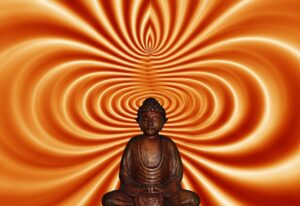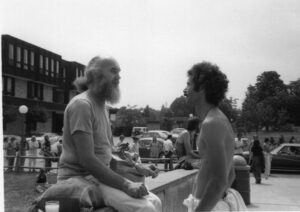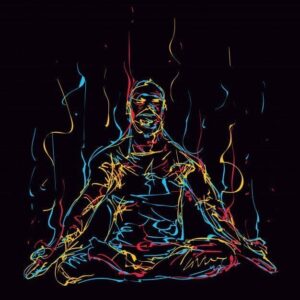Post Traumatic Stress Disorder, or PTSD, is a condition in which a person’s mind is stuck in some past traumatic event. This “disorder” is much more effectively treated with meditation than with any of the mainstream methods used by psychologists and psychiatrists in the western world today.
Meditation can be seriously helpful for people suffering from PTSD
Post Traumatic Stress Disorder, or PTSD, is a condition in which a person’s mind is stuck in some past traumatic event. This “disorder” is much more effectively treated with meditation than with any of the mainstream methods used by psychologists and psychiatrists in the western world today. 
Yesterday, I went on a snorkeling adventure with this beautiful Buddha I call my “girlfriend.” It was a lazy, partly-cloudy day, about 82 degrees Fahrenheit, and the peace and quiet of the ocean washed serenely over the shore.
The salty breeze floated gently by as the captain of the tour boat directed us to the safety officer to get our masks and fins.
“Damn,” said the safety officer, as he fumbled around in the bin, looking for the right sizes. He pulled out a bag, looked at it, and then sighed with exasperation. ”Of course, it’s the broken one,” he mumbled to himself as he put back the bag, and searched for another. Finally, he pulled out the right sizes and handed us our bags. The bin lid clanged shut behind him. Jon tensed up, grit his teeth and sighed audibly. He shook his head. ”Of course,” he mumbled to himself.
The safety officer was a man in his early 20′s. We’ll call him “Jon” for privacy’s sake. Jon had a kindly demeanor about him. You could tell that he wanted to be of service to people. He seemed like the kind of guy who did what he loved and loved what he did… a guy who lived to laugh and liked to make others smile. Yet here he was, exasperated at the smallest frustration. Something was not right.
This is exactly what I was thinking as I looked at him, curiously. Jon looked back at me, and he relaxed visibly in that moment. ”I haven’t slept in a while,” he said.
“Stressful job, out here on the sea,” said I, keeping a straight face in respect for his obvious unhappiness.
“No, it’s not the job,” said he. ”Last week, I got into a car accident. I was driving my car, and my buddy was on his motorcycle. I didn’t see him… he just… he crashed into the side of my car…”
Jon’s eyes seemed to glaze over for a moment.
“He passed away on Wednesday. We just had his wake. It didn’t even look like him anymore. And the worst thing… My girlfriend and her sister were in the car. They saw the whole thing. They…”
Jon paused again.
“I’ve been apologizing to them every day. I keep telling them ‘I’m sorry, I’m sorry.’” Jon paused. ”And they’re getting angry at me. They say ‘Jon, stop apologizing!’ But I can’t help it…”
I’ll spare you the gory details of the story as they were described to me at the time. I’ll leave it to you to imagine what Jon was remembering.
Can you imagine why Jon might have been so frustrated while trying to pull the bags out of the bin? Can you imagine why it might have irked him when the lid slammed shut behind him?
Later, on the hour-long boat ride out to the snorkel site, I talked to Jon a little bit about meditation. I told him, “Just try to remain aware of your breathing. It’s not as easy as it sounds. Your mind is going to start throwing thoughts into your head… probably images, or sounds from the accident…”
He said “Yeah, that’s exactly what keeps happening… I keep seeing it over and over in my head… I can hear the song that was playing on the radio… I can hear the sounds as he bounced off the curb and the bushes… I can hear the sound of my voice as I cried out his name as I ran across the road… the worst thing is that it keeps replaying over and over and over again in my dreams. That’s why I can’t sleep.”
Witnessing — and being involved in — the traumatic death of a friend is probably one of the most intensely emotional things a human being can experience. I think that would be putting it lightly. But there’s no reason to let it ruin your life as well.
PTSD is labeled a “disorder” by the western psychiatric model, and is considered to be something that is difficult to treat, requiring months, years, or even a lifetime of therapy, commonly coupled with powerful[ly harmful] consciousness-altering psychoactive drugs. Even after all of this treatment, there is often some residual trauma that lingers for the rest of the person’s life.
The National Institute of Health defines PTSD by using a certain set of signs and symptoms. You can read more about it (from the western perspective) here: www.ncbi.nlm.nih.gov/pubmedhealth/PMH0001923
In the meditative psychiatric model, on the other hand, PTSD is not seen as a “disorder” at all. In fact, there’s no such thing as “PTSD” in the meditative model, as an isolated phenomenon. The signs and symptoms delineated on the NIH website can all be seen as the inevitable outgrowth of the untrained mind when it encounters an unusually intense experience (such as witnessing — and being involved in — the traumatic death of a close friend).
Mindfulness training, through meditation, trains the mind to stay anchored in the present moment. Meditation trains the mind to place the present moment in the foreground at all times, no matter what stimuli arise in the field of consciousness. Thoughts, images, sounds… they are not ignored, but they are experienced IN THE CONTEXT OF THE PRESENT MOMENT. So when a thought, sound, or image arises in the mind, it is seen for what it is — a thought, sound, or image in the mind — instead of “relieved” as if it were actually happening right now.
The mind, in its untrained state, is very susceptible to being pulled away from the present moment.
Here you are, sitting, or lying down, reading some words on a screen. But how aware are you of the present moment, right now? The sounds of the room around you… notice them now, without moving your ears. The visual input… see everything in front of you now, without moving your eyes. Instead of just seeing these words on the screen, see the whole screen. And notice what you can see above and below the screen, to the sides… all without moving your eyes at all. Notice your body. Notice all the sensations in your body, from your head to your toes. Notice your breathing. ALL OF THESE THINGS were already existing in this moment. But as you were reading this article, you lost awareness of them. Your mind got sucked into the thoughts that were caused by the words on the screen, and you lost sight of the reality of HERE AND NOW.
Living in the present moment, in the here and now… noticing all of the sights, the sounds, the body sensations that exist RIGHT NOW… this is the only way to enjoy life. Because you can only experience those things in the present moment! You can remember something from a past moment, or fantasize about something from a future moment, but those experiences are only in your head… they are products of your imagination. The only way to EXPERIENCE LIFE is to experience it NOW.
So, when the untrained mind comes into contact with an extremely intense experience, it tends to hold onto the memory of that experience, very tightly. That memory has a very strong emotional charge. Whenever it comes up into the mind, the mind feels COMPELLED to focus on it.
And when the mind is continuously focused on its own images, sounds, and thoughts, there is no attention left for the experience of life, in the present moment. This leads to things like depression, a feeling of numbness, feeling “detached,” etc.
When the mind feels continuously compelled to focus on this one single memory, it becomes agitated when it gets “distracted” from those all-important mental sounds and images. Even something as simple as pulling the wrong snorkel bag out of the snorkel bin becomes a cause for frustration. ”Damn these snorkels! Damn this job for distracting me! This is all so stupid… why am I doing this? This is pointless. My friend is DEAD. Who cares about !@#$ing SNORKELS?” Can you imagine how angry you might become at the snorkels? At the silly laughing tourists who demanded them? How can they think about snorkels at a time like this?!? Imagine what you might do, in an outburst of righteous anger. If you’re lucky, you’d be able to vent your frustration like Jon, letting it out in every moment. Then you’ll only be seen as a “grumpy old crazy guy” instead of holding it all in and then exploding as a “violent psychopath.”
The startle response is a particularly telling sign of this psychiatric phenomenon. The lid of the bin slams shut, and Jon becomes tense. He is startled for a moment, distracting him from his thoughts, his all-important images. He needs to remember the accident. Maybe he will remember something that will make him feel better. Maybe he will find something in the memory that will allow him to let it go. He remembers how he turned the steering whee– !!!CLANG!!! Jon is pulled back into the present moment, on the snorkel dock. DAMMIT. Jon becomes angry at himself for allowing the lid to fall, to distract him from the all important memories. He’s been doing that a lot lately… messing things up (because of his lack of present-moment mindfulness), so that he has to deal with them again and again in the present moment. ”OF COURSE,” he says, frustrated at himself, and at the situation. And his mind goes right back to the steering wheel once again.
Unfortunately, time does not heal all wounds. This type of mental behavior is actually self-reinforcing. The more you let your mind get sucked into the past, the more you train your brain to stay focused on its memories, and the harder it is to concentrate your attention in the present moment. In some extreme cases, this type of mental activity can get worse and worse for the rest of a person’s life. Many people turn to alcohol to dampen the mind, to try to shut the memories out. And there you have the image of the stereotyped “homeless, disgruntled, alcoholic veteran.” ”PTSD,” manifested over many years.
When you understand PTSD in this way… from the perspective of the meditative psychiatric model… we can see very clearly how all of the symptoms cited on the NIH website arise from the untrained mind, getting pulled into its own thoughts and away from the present moment.
Meditation trains the mind to settle in the present moment. The more you practice, the more your brain stays anchored in the present moment. This is a function of neuroplasticity — the ability of your brain to actually re-shape itself based on your mental activity. The more you use a certain part of your brain, the stronger it gets. The less you use a certain part, the weaker it gets. Just like the muscles in the rest of your body.
So when the trained mind (a mind trained through many hours of meditation practice) encounters a traumatic event like the one that Jon experienced, it does not go into PTSD mode. The mind may continuously cycle through images and sounds and thoughts for a while… but the person stays centered in the present moment, allowing those thoughts and sounds and images to come and go without allowing them to pull him away from the reality of Here and Now. Over time, by EXPERIENCING LIFE and LIVING IN THE PRESENT MOMENT, the brain picks up new images, new sounds, new experiences… and those experiences replace the old ones in the cycle of mind. And on and on it goes. Thus, the trained mind does not pick up “traumas,” and it does not hold onto them for long periods of time. It experiences them in the moment, lets them go, and moves on. It allows the brain to heal, instead of forming physical scar tissue (neural networks associated with the trauma) that can take years to dissolve.
Luckily for Jon… and for anyone else dealing with PTSD… the brain remains plastic throughout a person’s entire life. Even as a dying old person, the brain is continuously reshaping itself, forming new neural pathways and allowing others to die out. So it’s never too late to start meditating. If Jon were to start meditating now, he might find it difficult to stay in the present moment, but with practice, he would be able to do it more and more easily. And the more he practices staying in the present moment, the more he will allow his emotional attachment to the mental sounds and images to fade away.
This doesn’t mean Jon will forget what happened. It just means that he won’t get sucked back into his thoughts every time he remembers the event. By letting go of his emotional reaction, Jon may ironically be able to remember the actual event better, when it is not clouded by his intense emotions. Jon’s memory of the event will go from an emotional “flashback” (as the NIH calls it) to a normal, level-headed memory, just like any other memory that you might have. Just the facts, unfiltered by the emotions of the present. To use the language of the Freudian paradigm: the emotional attachment is what causes the memory to become “repressed.” ”Letting go” allows the real memory to come back to the surface once again.
Meditation is a method of training the brain to “let go” by allowing it to stay calm, cool, and concentrated in the present moment, even as the images, sounds, and thoughts come up in the field of consciousness. Every time Jon stays calmly concentrated in the present moment, while facing these memories, he shapes his brain’s automatic reaction to them. His brain begins to react to the memories with more neutrality and less emotion. And this is how the scars of “PTSD” are dissolved.
Meditation is THE CURE for PTSD. It is a preventative treatment, to make sure that people don’t develop PTSD in the first place… and it can be used as a clinical treatment for those who have already developed those scars. This is another reason that Meditation needs to be formally (and culturally) incorporated into the western psychiatric paradigm.
“Jon,” if you’re reading this… there are lots of articles on this website about how to start meditating. Start with this one and go from there. Read them, try it for yourself. Feel free to contact me if you have any questions.















… [Trackback]
[…] Find More on on that Topic: meditationmag.com/blog/cure-ptsd-with-meditation/ […]
… [Trackback]
[…] Here you can find 14164 additional Info on that Topic: meditationmag.com/blog/cure-ptsd-with-meditation/ […]
… [Trackback]
[…] There you will find 86725 additional Info to that Topic: meditationmag.com/blog/cure-ptsd-with-meditation/ […]
… [Trackback]
[…] Read More on to that Topic: meditationmag.com/blog/cure-ptsd-with-meditation/ […]
… [Trackback]
[…] Read More to that Topic: meditationmag.com/blog/cure-ptsd-with-meditation/ […]
… [Trackback]
[…] Read More on that Topic: meditationmag.com/blog/cure-ptsd-with-meditation/ […]
… [Trackback]
[…] Information on that Topic: meditationmag.com/blog/cure-ptsd-with-meditation/ […]
… [Trackback]
[…] Find More Info here on that Topic: meditationmag.com/blog/cure-ptsd-with-meditation/ […]
… [Trackback]
[…] Here you can find 54098 more Info on that Topic: meditationmag.com/blog/cure-ptsd-with-meditation/ […]
… [Trackback]
[…] Find More on that Topic: meditationmag.com/blog/cure-ptsd-with-meditation/ […]
… [Trackback]
[…] Here you can find 41002 more Information on that Topic: meditationmag.com/blog/cure-ptsd-with-meditation/ […]
… [Trackback]
[…] Read More on on that Topic: meditationmag.com/blog/cure-ptsd-with-meditation/ […]
… [Trackback]
[…] Here you can find 70789 additional Information to that Topic: meditationmag.com/blog/cure-ptsd-with-meditation/ […]
… [Trackback]
[…] Here you will find 70679 additional Info to that Topic: meditationmag.com/blog/cure-ptsd-with-meditation/ […]
… [Trackback]
[…] Read More here to that Topic: meditationmag.com/blog/cure-ptsd-with-meditation/ […]
… [Trackback]
[…] Info to that Topic: meditationmag.com/blog/cure-ptsd-with-meditation/ […]
… [Trackback]
[…] Information on that Topic: meditationmag.com/blog/cure-ptsd-with-meditation/ […]
… [Trackback]
[…] Information on that Topic: meditationmag.com/blog/cure-ptsd-with-meditation/ […]
… [Trackback]
[…] Here you can find 71283 additional Info to that Topic: meditationmag.com/blog/cure-ptsd-with-meditation/ […]
… [Trackback]
[…] Read More on on that Topic: meditationmag.com/blog/cure-ptsd-with-meditation/ […]
… [Trackback]
[…] Read More on on that Topic: meditationmag.com/blog/cure-ptsd-with-meditation/ […]
… [Trackback]
[…] Find More Information here on that Topic: meditationmag.com/blog/cure-ptsd-with-meditation/ […]
… [Trackback]
[…] Read More to that Topic: meditationmag.com/blog/cure-ptsd-with-meditation/ […]
… [Trackback]
[…] Read More here to that Topic: meditationmag.com/blog/cure-ptsd-with-meditation/ […]
… [Trackback]
[…] Read More here on that Topic: meditationmag.com/blog/cure-ptsd-with-meditation/ […]
… [Trackback]
[…] Find More here on that Topic: meditationmag.com/blog/cure-ptsd-with-meditation/ […]